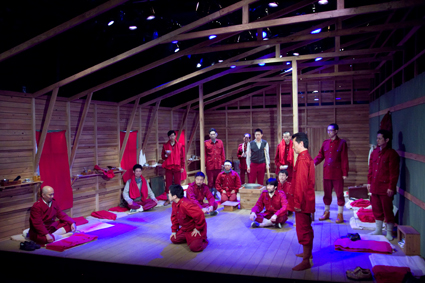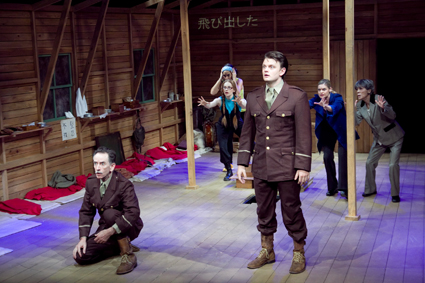War on the inside, on both sides
Zsuzsanna Soboslay: Honchos Meeting in Cowra

Cowra no Honcho Kaigi/Honchos Meeting in Cowra
photo Michihiro Furumoto
Cowra no Honcho Kaigi/Honchos Meeting in Cowra
Written and directed by prominent Japanese playwright Yoji Sakate, Honchos Meeting in Cowra sits within a post-WWII ‘small theatre’ tradition influenced by Chekhov and Ibsen as much as by Japanese Noh and Kyogen. The subject of this play is the Cowra breakout of August 1944 when 1,104 Japanese POWs escaped, 231 of whom were killed in the subsequent recapture, along with four Australians. The play’s focus is the redemption of identity and ‘face’ (or omote) by Japanese soldiers shamed by being captured. Hoping to be shot, the escapees possibly sought the means to die honourably by fighting or effectively committing suicide.
The play also looks to the contemporary context where the public in Japan remain misinformed of the effects of the recent Fukushima accident, unable to face the realities of that disaster.
The set represents a hut in the Cowra camp, replicating flimsy, fibro-thin walls (a pitched pine frame, joists exposed) with props such as tatami mats, toothbrushes, cups and forks and the bucket in which illicit sake is brewing. The details are significant, as we come to learn that this is actually a film set, part of an exercise where two contemporary, young Australian film students and their mentors from Australian and Japanese film schools are undertaking an ‘exercise’ to test their hypotheses as to why the POWS took the actions they did.
There are significant cross-cultural tensions, questions of honour and identity, the collective versus the individual, under investigation here. It is not just the POWs who suffer the effects of capture but also their relatives in Japan, who’d be subjected to extreme humiliation if it were known the men were captive. In many ways, this play is an attempt to understand, subvert and overwhelm that imperative. The final scene sees the young Australians urge the POWs to choose a different path from heading into suicide.
In this version of the story, the filmmakers being Australian smacks of Western imperialism, the superior, individualist, outsider view. The Tokyo original had these roles played by 15 young Japanese, which instead makes the questioning an inter-generational provocation. But within both conventions, the capacity to call ‘cut’ and have the final scene achieve a different outcome highlights the human capacity to create and remake different worlds.

Cowra no Honcho Kaigi/Honchos Meeting in Cowra
photo Michihiro Furumoto
Cowra no Honcho Kaigi/Honchos Meeting in Cowra
The strongest part of the play, however—in both imaginings—is surely when the POWs indulge the students’ wishful thinking but suddenly enact their own ‘cut’ and return to ‘what really happened.’ The men’s sense of shame cannot realistically be changed. So the play’s form is both linear and spiral, winding into the vortex, out into a world of different possibilities and then back in again.
The play passes from rather clunky didactic scenes, which serve to fill in historical detail, to disciplined comedic routines which borrow from their condensed, sharply-realised characterisations rooted in Kyogen (the lads in the barn, passing time), and then to intensely moving final scenes which combine both the refined stillness of Noh drama with the psychological depth of character and soul-searching we associate more with Western theatre, such as when the former group leader Murata, converses with the film producer, thinking she is his ghost. He is unsure who he has become, being incarcerated for so long. The part is beautifully played by Takahiro Onishi, his conscience stirred like turbulence deep within a lake.
Similarly, the ballot scene, where each POW is clearly expected to cast the vote to die rather than choose to live, is finely realised, each approaching the ballot box with an enormous sense of dignity and conscience. One man casts a vote to live. The one who seemed weakest in resolve but votes to die shows the full weight of a society unable to reveal what it feels resting on his shoulders. He is horrified. There is, perhaps, no one to blame. His fabric—the fabric of them all—has been frayed.
The set is lofty rather than claustrophobic, and the lighting its weakest element, too stark to be the dream it seems for re-thinking an historical event. Then again, its sharpness keeps the play from becoming an enactment of ‘forgiving the past, which I think it is not. The physicalisation of the Australian actors (building on a previous exchange between Sakate and NIDA in 2004) emulates the discipline of the Japanese actors but is odd in comparison: not that the Australian cast is weaker, rather their presence does not emerge out of a centuries old, deep-rooted practice where words and hieratic movement have evolved together. The slapstick in earlier scenes is particularly odd, not quite matching the sense of chiselled caricature of the POWs (although Matthew Crosby comes close in his various characterisations).
The intoning of both Japanese and English texts is almost identical from one performance to another, as in a musical score. Perhaps the characters are indeed dreaming each other. In Cowra—perhaps too in Japan—nothing in fact remains of these men apart from their headstones marked with false names. Members of the public—several from Cowra, whom I met both in the Canberra and Sydney showings—seemed deeply touched by a production that reveals hidden worlds in both sides of the experience.
Cowra no Honcho Kaigi/Honchos Meeting in Cowra, writer, director Yoji Sakatem, design Jiro Shima, lighting Isao Takebayashi, sound Takeshi Shima, costume Nobumo Miyamoto, choreography Mikuni Yanaihara; Cowra Civic Centre, Street Theatre, Canberra, NIDA Parade Theatres, Sydney, 1-10 Aug
RealTime issue #123 Oct-Nov 2014 pg. 38






